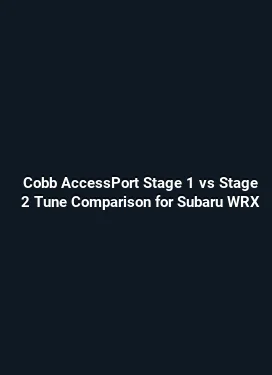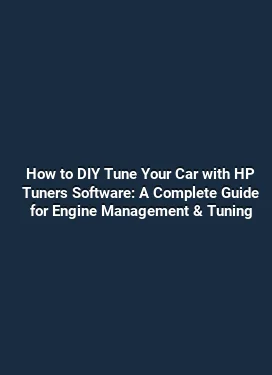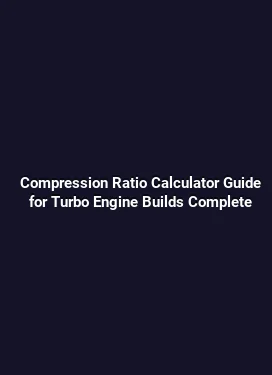How to Install Cosworth High Performance Valvetrain Components
Understanding the Cosworth Valvetrain Kit and Its Performance Promise

The Cosworth high performance valvetrain kit is designed to maximize airflow, improve valve control, and sustain peak performance under elevated RPM and load. This kit typically includes upgraded camshafts, lifters, valve springs, retainer hardware, seals, and sometimes durably engineered pushrods or rockers depending on the platform. Before starting, map out the engine’s intended use—drag, road course, or daily driven with occasional track days—as this informs cam timing, spring rates, and lash targets. A well-matched valvetrain works in concert with the rest of the engine, including the intake, exhaust, and fuel delivery systems, to deliver consistent cylinder filling and predictable valve control across the rev range. Assembly quality begins with inspecting each component for finish, straightness, and proper diameters. Check cam journals for nicks, lifter faces for flatness, and valve seats for seating height. Keep surfaces clean and free of debris; small particles can cause seat recession or uneven spring load early in break-in. The goal is retention of spring tension, precise valve motion, and reliable sealing under higher spring forces. When everything is verified, photograph critical tolerances and record the exact kit variant and part numbers for future reference, as different Cosworth kits may have distinct required tolerances and assembly procedures.
From a performance standpoint, high quality valvetrain components reduce parasitic loss and maintain valve train geometry under higher rpm. Expect improved throttle response, a flatter torque curve, and better high-end breathability when the kit is properly installed and calibrated. It’s important to understand the interplay between valve timing events and the engine’s breathing characteristics. A well-chosen cam profile—lift, duration, and ramp rate—will harmonize with the valve spring’s natural frequency to avoid float at elevated rpm. This harmony translates into consistent cylinder filling and robust high-rpm operation, which are essential for reliable power delivery in performance applications.
Preparation, Tools, and Workspace Setup
Preparation is the foundation of a successful valvetrain installation. Create a clean, well-lit workspace with ample bench space, a magnetic tray for fasteners, and a torque wrench with the correct range for head and cam gear fasteners. Establish a parts catalog that includes the Cosworth kit contents, OEM shims or spacers, and any platform-specific references. Before lifting the engine or removing major components, disconnect the battery, drain fluids, and tag wiring harnesses to simplify reassembly. A clean, organized environment reduces the risk of contamination and makes cross-checking tolerances a straightforward task. Document the factory valve lash, cam timing, and rocker geometry if accessible. This baseline helps establish a repeatable reference during the post-install tuning and break-in process. For engines with hydraulic lifters, ensure the lifter bore diameters are free from scoring or burrs that can trap oil or create improper valve seating. Fatigue and heat soak are real concerns in performance builds, so plan for a thorough inspection of the cylinder head, cam caps, and timing cover surfaces to ensure there are no distortions that could influence timing or sealing integrity.
Choosing the Right Tools for Precision

Precision is non-negotiable when handling high-performance valvetrain components. Use a torque wrench with a calibrated driver, a dial indicator for valve lash checks, and a camshaft alignment tool if your platform requires it. A micrometer or vernier caliper helps verify lifter diameters, valve guide clearance, and retainer seating depth. A ring compressor or head gasket alignment tool can prove invaluable when reassembling the cylinder head on a complex valvetrain upgrade. Finally, a good quality assembly lube is essential for smooth initial startup and to protect against initial startup wear while the oil system scavenges the new components.
Disassembly: Surface Prep and Inspect Before You Install
Disassembly should be deliberate and methodical. Remove the rocker covers, disconnect the camshaft end play indicators if present, and carefully extract the camshafts one at a time, noting the orientation and any shims or spacers. Inspect the cam bearings for oil starvation signs and measure cam lobe wear using appropriate gauges. If the engine has adjustable cam gears, document their original timing marks to facilitate proper re-timing after the new cams are installed. Surface prep is critical; clean mating surfaces on the head and timing cover to ensure proper sealing with new gaskets and or o-rings. Replace any degraded gaskets or seals during reassembly to prevent leaks and moisture intrusion that could compromise the valvetrain’s stability under pressure. Pay close attention to the valve springs. Pushrods or rockers may require replacement or inspection to ensure no binding or excessive stiffness. Surface contaminants can prematurely wear the cams, lifters, and valve stems, so remove debris with lint-free towels and solvent, then rinse thoroughly and allow to dry before proceeding. This stage also offers an opportunity to quantify the baseline valve lash and ensure correct lifter preload before installing the Cosworth components.
Camshafts, Lifters, and the Primary Installation Sequence
Installing the Camshafts and Lifters is a critical step that directly influences valve timing accuracy and durability. Begin by aligning the camshaft timing marks with the factory or Cosworth-specified reference. For hydraulic lifters, ensure the lifters are primed with oil before installation to prevent dry starts. When securing the camshaft, follow the recommended torque sequence and use the supplied caps or bolts with the proper lubricants. A multi-lumen feeler gauge or a dedicated lash checker will help you measure the valve lash accurately while the cam is in the installed position. After the cam is seated, rotate the engine by hand to verify smooth operation through a full cycle, listening for unusual stumbles or contact noises that would indicate a misassembly or binding condition. For some Cosworth kits, a specific cam phasing or adjustment is required. If this is the case, install the phaser in accordance with the kit instructions and ensure that the phasing remains locked in place under the recommended load conditions. A misaligned phaser can lead to valve-to-piston interference or degraded valve timing stability, especially at high rpm. If the engine uses variable valve timing, confirm the ECU or engine control logic is compatible with the new phasing characteristics and does not enter fault states during operations.
Technical Note: Cam Profile Selection and Practical Limits
Cosworth typically provides several cam profiles tailored to different rpm bands and breathing characteristics. A mild upgrade may emphasize low-to-mid range torque for street use, while a more aggressive profile shifts power higher into the rev range. When selecting a profile, consider existing supporting modifications: intake manifold, exhaust tuning, fuel delivery, and engine breathing efficiency. A cam with high lift requires a corresponding increase in valve spring rate and seat pressure to prevent float, especially at elevated RPM. Always verify that the combination of cam, springs, and valve train geometry remains within the engine’s mechanical limits to avoid valve float, piston contact, or excessive valve train load at peak rpm.
Valve Springs, Retainers, Seals, and Geometry Alignment
Upgrading valve springs is essential when raising valve lift or rpm. Springs must be matched to cam lift, ramp rate, and the installed height to maintain proper seat pressure across the engine’s operating envelope. Inadequate spring stiffness can lead to valve float, while overly stiff springs can increase valve train wear and cause premature wear on the cam lobes. Retainers and locks should be compatible with the new spring seats and must retain valve bridges securely in place even under high acceleration and vibration. Seals should be compatible with racing or high-temperature operation to ensure consistent valve sealing and oil control. Geometry alignment refers to ensuring the valve stem, lifter, and rocker geometry maintain proper contact throughout the cycle. A mismatch can lead to accelerated wear and reduced valve herding efficiency, compromising both reliability and performance. A practical approach is to measure seat height, guide clearances, and keepers with a precise height reference. After installation, rotate the engine by hand through several cycles to confirm stable contact patterns and to identify any binding or unusual resistance. Periodic re-checks during the initial break-in are recommended to verify that tolerances are maintained as parts settle and surfaces wear to their intended profiles.
Timing, Cam Phasing, and Engine Management Considerations
While the mechanical installation is essential, the electronic control strategy plays a critical role in extracting maximum efficiency from Cosworth valvetrain upgrades. Proper timing and calibration influence ignition timing, fuel delivery, and air-fuel ratio control, ensuring the engine remains within safe operating temperatures and simulated load conditions. When the cam timing is changed, the engine’s volumetric efficiency profile shifts; this can affect fuel demand and ignition curves. Carefully map out a tuning plan that aligns with the new cam profile. Data logging of knock sensitivity, air-fuel ratio at various rpm, and manifold pressure helps tailor ignition and fueling to anticipate the valvetrain’s performance characteristics. Make sure to respect the engine’s stock or upgraded fuel system limits. If you’ve increased efficiency by improving airflow, you might need to adjust injector sizing, fuel pressure, or a larger capacity fuel pump. In advanced setups, throttle response and transient fueling can benefit from a dedicated engine management strategy that accommodates revised cam timing, variable valve timing (if present), and the altered breathing characteristics. The ultimate objective is clean, repeatable, and safe operation across all load and rpm ranges, with a stable idle and robust throttle response at low rpm as well as strong power delivery at peak rpm.
ECU Tuning: Practical Steps for Real-World Gains
Begin with a conservative baseline tune that respects the engine’s revised breathing profile and the new valve train geometry. Increase ignition advance gradually within safe limits, monitor knock, and ensure the air-fuel ratio remains within target bands under load. Use a wide-band O2 sensor to observe real-time fueling across idle, cruise, and full-throttle accelerations. Keep an eye on intake manifold pressure to confirm the engine does not lean out during high-RPM operation. When adjusting fueling, verify that injector duty cycle and fuel pressure margins remain ample to prevent short-term lean spikes that could lead to overheating or pre-ignition. A practical technique is to perform incremental pulls on a dyno or a controlled road environment while logging data. Compare the torque curve with the stock baseline and look for a smooth transition between low, mid, and high rpm ranges. If the cam profile is aggressive, you may see a pronounced peak, but ensure there is no excessive surge or misfire at mid-range while returning to idle without stumble. After the initial tuning, drive the vehicle under varying conditions to validate stability and response before proceeding to more aggressive tuning phases.
Break-In Procedure for Longevity and Reliability
A disciplined break-in procedure protects the investment in Cosworth valvetrain components. Start with a warm engine and limit RPM to a safe window recommended by Cosworth for the specific kit. Avoid sustained high RPM during break-in and refrain from hard accelerations. Maintain steady manifold pressure and moderate engine load to allow the components to settle and mating surfaces to conform properly. Use a light load cruising phase and then progressively increase revs in small increments while monitoring oil pressure and temperature. Replace oil and oil filter after the break-in cycle to remove any contaminants from the new parts and to reset the lubrication system with clean oil designed to handle higher temperatures and durations. During break-in, closely monitor valve lash, cam timing, and smoothness of operation. Abnormal noises, inconsistent oil pressure, or misfire symptoms should trigger immediate inspection and corrective action. A cautious approach minimizes the risk of early failures and extends the life of the valvetrain by allowing the parts to wear in together under controlled conditions.
Maintenance, Diagnostics, and Common Troubleshooting
Maintenance remains the cornerstone of sustained performance. Regular inspection of valve seals, rocker arms, and lifters helps prevent leaks and misalignment. Periodic compression checks and cylinder leak-down tests illuminate issues with sealing, valve seat seating, or guide wear that could be aggravated by high-performance operation. For owners pushing the envelope with aggressive cam profiles, anticipate more frequent inspection intervals to ensure the springs maintain proper seat pressure and do not fatigue under heavy valve train loads. Diagnostics should include a thorough review of ignition timing, fuel trims, and idle stability. If you notice misfiring at specific RPM ranges or a loss of power at high RPM, re-check cam timing marks, lifter preload, and the condition of valve springs. Engine management software updates or calibration adjustments may be necessary when the hardware has shifted the breathing characteristics beyond what the stock calibration anticipated. In some cases, a refreshed calibration with new self-learning parameters helps the engine settle into the new hardware configuration and maintain consistent performance over time.
Optimizing Braking-In and Practical Road Testing
Once the initial break-in is complete, practical road testing helps confirm the kit’s real-world performance. Evaluate throttle response, mid-range torque, and high-end power consistency. Document any altitude or ambient temperature effects that influence air density and fuel requirements. Use a controlled environment to test transmission behavior under heavy acceleration to ensure that the new valvetrain configuration does not impose unexpected load on the engine management strategy. Record data sets that capture RPM transitions, engine load, and knock events to build a robust tuning map that can be referenced under varied driving conditions.
Cosworth Valvetrain Lifecycle: Longevity, Upgrades, and Upkeep
Investing in a Cosworth valvetrain is a long-term project that benefits from a well-planned upgrade path. When planning future enhancements, consider compatibility with upgraded intake, exhaust, and cooling components. A holistic approach to engine performance considers not only the valvetrain but also the potential gains from a tuned fuel system, improved air intake, and efficient exhaust routing. Regular maintenance checks and timely replacements of wear-prone components help preserve the reliability that performance enthusiasts expect. A disciplined maintenance schedule keeps the system in peak condition and reduces the risk of unexpected downtime on track days or spirited drives.
Reliability and Real-World Performance Metrics
Cosworth valvetrain installations are designed to deliver measurable gains in power, throttle response, and sustained high-RPM performance. Real-world success is built on meticulous assembly, precise tolerances, and disciplined tuning. Data-driven validation—combining dyno results with road testing and robust logging—yields a comprehensive view of how the kit behaves across the rev spectrum. This evidence-based approach helps enthusiasts understand how each modification contributes to overall performance and reliability, guiding future upgrades and maintenance practices.
Summary of Best Practices for a Successful Install
Best practices begin with a thorough assessment of the engine’s current condition and a well-defined performance goal. Maintain a clean, organized workspace and verify every component before installation. Use the correct tools, adhere to torque specifications, and respect the cam timing references. During the break-in and tuning phases, document all settings, monitor data closely, and proceed with incremental adjustments to avoid destabilizing the engine’s behavior. Finally, implement a robust maintenance plan that includes regular inspections, oil analysis where applicable, and a proactive approach to replacing wear-prone items before they reach critical limits.
Conclusion: The Path to Consistent, High-Performance Valvetrain Operation
Installing Cosworth high performance valvetrain components is a multidisciplinary process that blends mechanical precision with smart engine management. By aligning hardware choices with breathing characteristics, tuning strategy, and practical break-in procedures, a performance build can deliver strong power, reliable operation, and repeatable results across a broad range of driving conditions. The result is a more responsive engine, improved air flow management, and a robust platform that can sustain high-performance operation with predictable behavior and long-term reliability.






